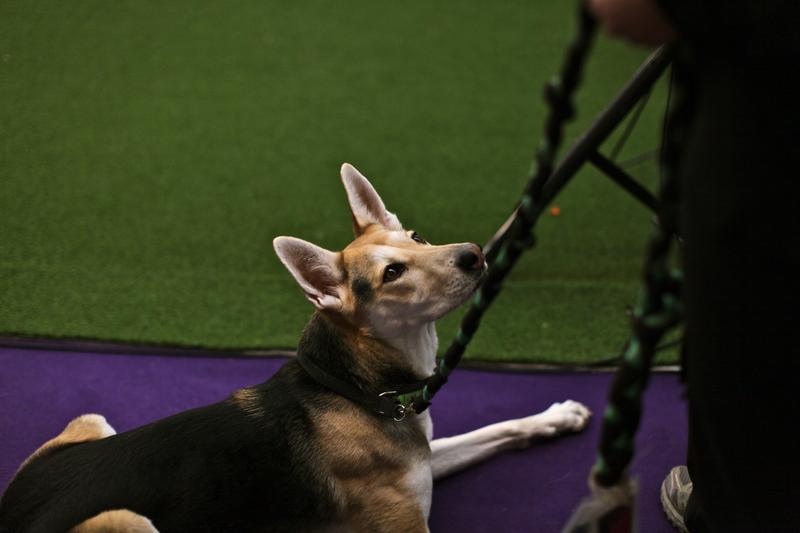
The Westminster Kennel Club held its first annual Masters Agility Championship on Saturday—a competition where dogs are judged on their performance over obstacles, not on appearance or breeding. This means that the American Kennel Club (AKC), the oversight body for recognized dog sports, allows mixed-breed dogs to compete alongside purebreds.
This sends an important message, says Stacy Campbell, whose Husky mix Roo! was the winner of the 24” division (dogs compete in different height classes), and was also declared Best All-American Dog, which is the official designation for mixed-breeds in AKC competitions.
Agility competitor Emma was rescued by Christy Wrede from a kill shelter in South Carolina. (Amy Pearl/WNYC)
“It just makes people think, well I don’t have to go to a breeder to get a dog, I can maybe go to my local rescue group to adopt a shelter dog, and now that AKC is allowing mixed breeds to compete it’s just opening more doors for them.”
Roo! came from the San Francisco SPCA, and was rejected twice before finding her calling with Campbell.
Sara Beth Pinson showers praise on All-American Dog Icey. (Amy Pearl/WNYC)
And it’s not only mixed breeds who get a look in. A number of competitors had pet-shop specials—dogs who are the products of puppy mills and without pedigrees or provenance. Katrina Krings works with her tiny Brussells Griffon Stella, whom she describes as “a pretty serious competitor” in the 8” division. “We never could have competed in conformation, she’s originally from a puppy mill and doesn’t have the sort of structure to do that, but this is something that we can do that really showcases the training we’ve put into this.”
Agility competitors Chili and Salsa are both Petit Basset Griffon Vendeens (PBGVs) owned by Megan Esherick. (Amy Pearl/WNYC)
The exclusivity of the traditional conformation shows isn’t snobbery—they just have a different mission. We don’t hate fashion models for being unusually attractive and usually leggy: they are professionals whose job it is to be eye-catching and to wear clothes well. The job of purebred show dogs is to be eye-catching and wear the history of their breeds well.
These two ladies are content to watch the proceedings from the sidelines. (Amy Pearl/WNYC)
“In conformation they’re trying to make the breed better, but agility is just a sport you can do with your dog,” commented Jennifer Thomas, who thought her dog wouldn’t be able to cope with the crowds, but was here supporting friends.
Successful agility dogs “have to have great obedience, be able to listen to you, follow direction, have focus, and be able to deal with all of this here.”
Not just a pretty face: A Standard Poodle takes a hurdle on the agility course at Westminster. (Amy Pearl/WNYC)
“This here” included a packed arena with a Fox Television crew and an enthusiastic audience which quickly picked up on the challenges of this fasting-growing dog sport. A typical course includes jumps, weave poles, A frames, teeter-totters, and hoops, and the crowd cheered great rounds and moaned in consternation when something went wrong.
“It was definitely great and it was amazing to listen to the crowds when the All-Americans were announced—they were very supportive of it,” said Stacey Eastman, who was very pleased with her 4th place finish in the 20” class with Australian Shepherd/Cattle dog mix Panda.
Panda, a mixed breed or "All-American Dog" watches a fellow competitor pass by while waiting for his run. (Amy pearl/WNYC)
Agility’s inclusive spirit also embraces the human end of things. In large all-breed shows like Westminster, most of the handlers are professionals. In agility, almost all are owner-amateurs, including 66-year old Loren Dribinsky, who praises her 5-year-old Icelandic Sheepdog, Luke. “He’s a very special dog. He’s slow but he does it for me.”
Loren Dribinsky gives a squeeze to Luke the Icelandic Sheepdog. (Amy Pearl/WNYC)
Herding breeds do seem to have something of an advantage—and the overall winner Saturday night was Kelso, a 7-year-old Border Collie owned by Delaney Ratner, who’s been competing in agility since she was six. “He’s a very naturally talented dog, he’s so athletic, and he’s a really really great learner.”
A West Highland White Terrier watches the competition intently at The Masters Agility Championship at Westminster. (Amy Pearl/WNYC)
One competitor thought that herding dogs do so well because they are used to working with people at a distance—in the agility ring, the handler runs alongside the dog signaling the course.
Adrienne McLean says that this part of working with Jimmy, her mixed breed 16” partner (“all anyone knows is that is mother was a Chihuahau”) is not only strategy, but what makes agility magical:
Jimmy gets a few words of encouragement from his owner Adrienne McLean before his run. (Amy Pearl/WNYC)
“If they like doing agility, it’s like you have them on a piece of elastic. And they can be a 100 yards away from you but they are still fully aware of what your body is doing; it’s an amazing dance with your dog.”
That, says Loren Dribinsky, is what the Masters Agility Championship represents: “It’s Westminster’s recognition that dogs are for beauty—and for performance—and for bonding.”
Cash (short for Johnny Cash, the man in black) the Field Spaniel belongs to Karin Wiechmann and is the only Field Spaniel entered in the The Masters Agility Championship. (Amy Pearl/WNYC)